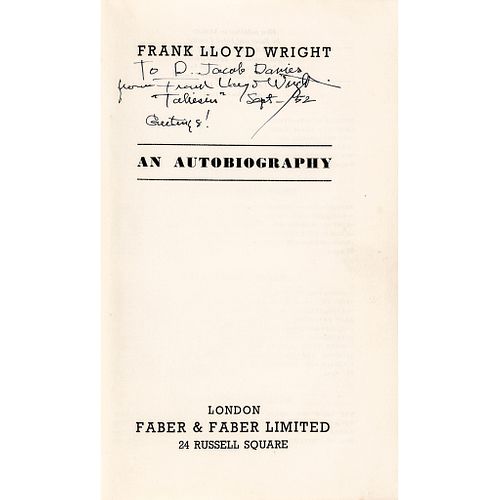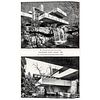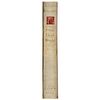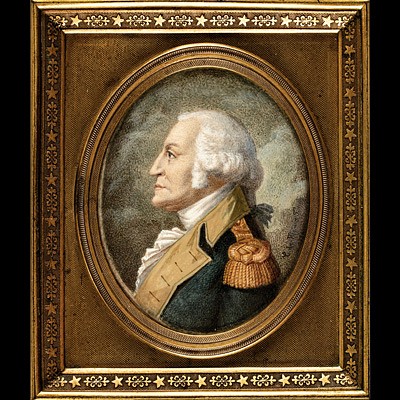1943 Frank Lloyd Wright Signed + Inscribed: FRANK LLOYD WRIGHT: An Autobiography
Lot 54
Estimate:
$2,200 - $2,400
Absentee vs Live bid
Two ways to bid:
- Leave a max absentee bid and the platform will bid on your behalf up to your maximum bid during the live auction.
- Bid live during the auction and your bids will be submitted real-time to the auctioneer.
Bid Increments
| Price | Bid Increment |
|---|---|
| $0 | $10 |
| $200 | $20 |
| $300 | $25 |
| $500 | $50 |
| $1,000 | $100 |
| $2,000 | $200 |
| $3,000 | $250 |
| $5,000 | $500 |
| $10,000 | $1,000 |
| $20,000 | $2,000 |
| $30,000 | $2,500 |
| $50,000 | $5,000 |
| $100,000 | $10,000 |
| $200,000 | $20,000 |
| $300,000 | $25,000 |
| $500,000 | $50,000 |
About Auction
By Early American History Auctions
May 22, 2021
Set Reminder
2021-05-22 12:00:00
2021-05-22 12:00:00
America/New_York
Bidsquare
Bidsquare : Autographs-Colonial-Political-Americana
https://www.bidsquare.com/auctions/early-american-history-auctions/autographs-colonial-political-americana-6913
302 Lots of Rare, Historic Autographs, Americana, Civil War Era, George Washington, Abraham Lincoln, Slavery & Black History, Revolutionary War Era, Colonial America, Federal Period, War of 1812, Colonial Currency, Indian Peace Medals & more... Early American History Auctions auctions@earlyamerican.com
302 Lots of Rare, Historic Autographs, Americana, Civil War Era, George Washington, Abraham Lincoln, Slavery & Black History, Revolutionary War Era, Colonial America, Federal Period, War of 1812, Colonial Currency, Indian Peace Medals & more... Early American History Auctions auctions@earlyamerican.com
- Lot Description
Autographs
Choice Copy of "Frank Lloyd Wright: An Autobiography" that was Personally Signed & Inscribed at "Taliesin" in 1952
FRANK LLOYD WRIGHT (1867-1959). Famous American Architect, often considered the greatest U.S. Architect of all time, his greatest legacy is "Organic Architecture," or the idea that buildings harmonize both with their inhabitants and with their environment.
1943-Dated Book, "Frank Lloyd Wright: An Autobiography," Signed, "Frank Lloyd Wright", measuring 9.5" x 6.25", Choice Very Fine. Printed by Faber & Faber Limited, London, the book contains 486 pages, and has a subtitle: "Five Books in One Volume." There are 16 black and white photo plates in the book, front and back, bearing 76 pictures of various Wright-designed homes. An Inscription is written in ink on the title page reading: "To D. Jacob Davies from Frank Lloyd Wright. Taleisin. Sept. '52. Greetings!" "Taliesin" West was architect Frank Lloyd Wright's winter home and his school in the desert in Scottsdale, Arizona, residing there from 1937 until his death in 1959 at the age of 91. The receipient, "D. Jacob Davies" (1916-1974) was a rather famous Welsh Unitarian Minister who became a prominent figure within Welsh public life, within his denomination in Wales and beyond. There is light wear on the corners and edges of the covers and very light tone to the outside page edges. Its "Frank Lloyd Wright" autograph and inscription are in excellent condition. Overall, a wonderful Signed and Inscribed book.
Frank Lloyd Wright (1867-1959) was born in Richland Center, Wisconsin, where one of his early building designs still stands. After studying engineering briefly at the University of Wisconsin, he worked for the firm of Dankmar Adler (1844-1900) and Louis Sullivan in Chicago, before opening his own practice there in 1893.
Wright became the chief practitioner of the Prairie School, building about 50 Prairie houses from 1900 to 1910. Early nonresidential buildings include the forward-looking Larkin Building in Buffalo, N.Y. (1904; destroyed 1950), and Unity Temple in Oak Park, Ill. (1906). In 1911 he began work on his own house, Taliesin, near Spring Green, WI. The lavish Imperial Hotel in Tokyo (1915-22, dismantled 1967) was significant for its revolutionary floating cantilever construction, which made it one of the only large buildings to withstand the earthquake of 1923.
In the 1930s he designed his low-cost Usonian houses, but his most admired house, Fallingwater, in Bear Run, Pa. (1936), is an extravagant country retreat cantilevered over a waterfall. His Johnson Wax Building (1936-39), an example of humane workplace design, touched off an avalanche of major commissions.
Of particular note is the Guggenheim Museum (1956-59), which has no separate floor levels but instead uses a spiral ramp, realizing Wright's ideal of a continuous space. Throughout his career he retained the use of ornamental detail, earthy colours, and rich textural effects. His sensitive use of materials helped to control and perfect his dynamic expression of space, which opened a new era in American architecture.
Often considered the greatest U.S. architect of all time, his greatest legacy is "organic architecture," or the idea that buildings harmonize both with their inhabitants and with their environment.
Jacob Davies was born on 15 September 1916 at Penlon, Tregroes, near Llandysul, one of the five children of David and Mary Davies. He was educated at Tregroes Primary School before earning a scholarship to Llandysul Grammar School in 1929, where he remained until 1936.
He then became a student at Carmarthen Presbyterian College to prepare for the Unitarian ministry. After some years in Carmarthen he became minister of the Capel Bach, the Unitarian chapel in Aberystwyth, where he enrolled as a student at the University and graduated in 1945.
In 1957, Jacob Davies returned to his native area to minister the three Unitarian churches at Alltyblacca; Capel y Bryn, Cwrtnewydd and Cwmsychbant. He remained there until his death in 1974.
Davies was an active broadcaster, writer and journalist, and edited the Unitarian journal, Yr Ymofynnydd. He was an active campaigner for pensioners' rights and the Pensioner of Wales from 1955 until 1973. He was in demand to preside at the National Eisteddfod of Wales and the Llangollen International Eisteddfod.
Politically, Davies supported Plaid Cymru, and unsuccessfully stood as a candidate in the inaugural Dyfed County Council election in 1973. He finished fourth with 21% of the vote.
Together with these various activities, Davies was prominent in his denomination beyond Wales and at the time of his death was President of the General Unitarian Assembly.
Davies died suddenly on 11 February 1974. He was buried four days later at Bwlchydadfa Cemetery, Talgarreg.
Our Auction Contents:
Black History & Slavery: (Lots 1 - 63)
Abraham Lincoln Related: (Lots 64 - 74)
Historic Autographs: (Lots 75 - 235)
Colonial America: (Lots 236 - 261)
Revolutionary War: (Lots 262 - 304)
George Washington Related: (Lots 305 - 306)
Early American Guns & Weapons: (Lots 307 - 318) - Shipping Info
-
Early American provides in-house worldwide shipping. Please contact us directly if you have questions about your specific shipping requirements.
-
- Buyer's Premium



 EUR
EUR CAD
CAD AUD
AUD GBP
GBP MXN
MXN HKD
HKD CNY
CNY MYR
MYR SEK
SEK SGD
SGD CHF
CHF THB
THB
















